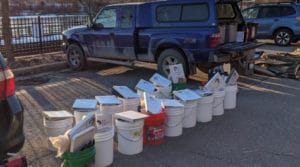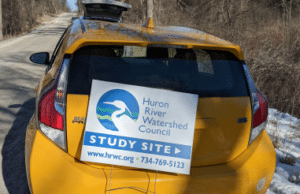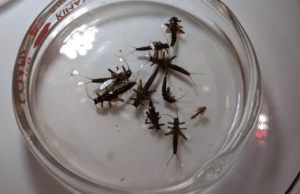Like all events held during the pandemic, this year’s Stonefly Search in January looked a little different. Volunteers met in the parking lot of HRWC’s office instead of inside to gather equipment, face masks were required, and social distancing protocols in place. The event was only open to returning volunteers, as HRWC was unable to host a new volunteer training or gather in large numbers due to COVID-19 safety concerns.
Thanks to the enthusiasm and dedication of our volunteer community, this year’s Stonefly Search was a success despite these challenges. The weather was cold, but the sun was shining, and everyone was excited to get outside and contribute to this vital water quality monitoring event.
Searching for Stoneflies

Volunteers visited 32 sites across the watershed on the hunt for stoneflies, a type of aquatic macroinvertebrate (insect) that are very sensitive to pollution and habitat degradation. Finding stoneflies in rivers and creeks is an indicator of good water quality, and HRWC tracks trends in stonefly abundance over time to keep an eye on water quality across the Huron River watershed.
Teams collected all the stoneflies they could find at their sampling sites. Afterwards, trained volunteers and staff identified the individual stoneflies taxonomic families, or groups. HRWC watershed ecologists consider both the number of stoneflies collected and variety of families found to determine whether water quality in an area has improved, declined, or remained stable over time.
Highlights from this year’s search
Last year we noted several sites where the average abundance of stonefly families had either increased or decreased in recent years compared to historic averages. Sometimes changes are due to seasonal variations or sampling errors; keeping an eye on a site’s trend over time helps us to better understand whether a change in stonefly abundance could be related to water quality conditions.
A few streams to watch

Volunteers did not find any stoneflies in Boyden Creek at Delhi Road for the third time in the last five sampling years. Stoneflies of the family Capniidae were reliably found here prior to 2013. Mill Creek at Fletcher Road tells a similar story: Stoneflies of the families Capniidae and Taeniperygidae were found here regularly in the past. However, no stoneflies have been found in the last three years of sampling, including this year. Mill Creek at Ivey Road has also exhibited a decline in stonefly abundance in recent years, with stoneflies found in only 3 of the last 6 sampling years. These declines are notable, as the sites at Ivey and Fletcher are on the same branch of Mill Creek. HRWC keeps an eye on trends like these by monitoring additional water quality indicators and investigating potential causes of habitat degradation in the region.
Following many years of successful stonefly collection at Hay Creek at M-36, no stoneflies were found last year. However, capniids were once again found in this year’s samples. This is good sign for the creek, and an example of the importance of drawing conclusions from multi-year trend analysis rather than individual sampling events.
Honey Creek at Jackson Road was noted last year as having an increased abundance of stoneflies in recent years compared to historic averages – this trend appears to be continuing, with volunteers finding a few capniids during the 2021 search.
Not much change

Few of our Huron River sites showed significant changes in stonefly abundance in recent years and this year’s count was similar. Perlodid stoneflies were found for the third sampling year in the Huron at Zeeb Road, in addition to the usual capniids and taeniops. Volunteers did not find any stoneflies in the Huron at White Lake Road for the second time in 17 years of sampling – however, abundances at this site have only ever been modest.
Finally, Mann Creek at VanAmberg Road remains the best stonefly site that we monitor, with four stonefly families consistently found there, including this year’s samples.
See a full report of 2021 stonefly data from all of this year’s sites here.
In other news
While our aquatic insect monitoring sites have been in place for many years, HRWC staff make the occasional modification to sampling locations. This year we replaced site 51, the Huron River at US-23, with newly christened site 103, the Huron River at Huron Meadows Metropark. The Huron in this part of the watershed is usually deep and fast flowing year-round, making sampling in this area difficult. The switch from 51 to 103 was an attempt to keep our general monitoring area intact while allowing easier access to the river for our volunteers. Site 23, the Huron River in Flat Rock, was also relocated as the old site was often flooded and difficult for volunteers to sample.
Check out information on all of the Huron River watershed’s 22 creeks and the river via HRWC’s Info Stream map
Stonefly on the fly
Here are some snippets of the event so you can see the action.
Volunteer with us!
If you’re interested in volunteering with HRWC’s River Roundup (spring and fall) and Stonefly Search (winter), our three macroinvertebrate monitoring events, please sign up here. We are hoping to welcome new volunteers eager to learn about the watershed and collect great data with our veteran volunteer team leads as soon as it is safe to do so.



